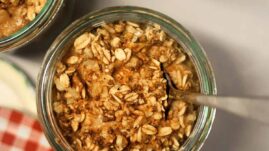This post may contain affiliate links. Please read our disclosure.
If you live with diabetes, you may know that trying to eat pizza while juggling unruly blood sugar levels and unpredictable insulin dosages can spell disaster.
However, pizza is delicious (and can be nutritious!), and if you’re a pizza lover who happens to have diabetes, you shouldn’t feel as though you need to cut pizza completely out of your diet to live a healthy, balanced life.
This article will explore how to manage your blood sugar when eating pizza as a person with diabetes, and what the best options are if you’d like to include this food into your life in as healthy a way as possible.

Why eating pizza can make your blood sugar go crazy
Carbohydrate counts for pizza can vary greatly, but an average piece (107 grams) from an average 14” regular crust pizza has 36 carbohydrates.
A few slices of pizza with a few sides and you can easily eat over 100 grams of carbohydrates in a single sitting!
What makes the carbohydrates in pizza even more difficult is that with the addition of dietary fat and protein, it becomes a lot harder to bolus for, if you have diabetes.
Fat and protein slow down the digestion of carbohydrates, which is great, but this can require a more complex insulin bolusing scheme, which can be very difficult to master.
How to manage insulin when eating pizza
If you take insulin and are on MDI (Manual Daily Injections), consider pre-bolusing your insulin to make sure you don’t see a huge blood sugar spike as soon as you start eating.
Depending on the type of insulin you take, 10-15 minutes before you start eating is a good time frame for a pre-meal bolus.
Some insulin pumps will suggest what is known as a square bolus, a dual wave bolus, or an extended bolus that gives you insulin up front for the carbohydrates you’re eating in the moment, followed by an additional bolus several hours later.
This can help you avoid a blood sugar spike due to the protein and dietary fats that will take some time to digest.
Talk with your doctor to see if an alternative bolusing scheme may help you eat pizza with more ease.
How to make pizza healthier and easier to take insulin for
Think of a pizza as a blank slate. You can load it up with as many healthy proteins, vegetables (and even fruits!) as you wish.
Add healthy vegetable toppings
Popular and healthy low-carb pizza toppings include: mushrooms, green bell peppers, onions, zucchini, yellow squash, garlic, spinach, olives, artichokes, broccoli, and, of course, tomatoes!
Even if you prefer your pizza plain, the tomatoes that make up the tomato sauce on the pizza are full of Vitamin C, Vitamin A, Niacin, Vitamin B6, Riboflavin, and Copper.
Plus, when most vegetables are added to the top of a pizza, they’re not fried, breaded, or even boiled; they’re baked right on, which not only makes them healthier, but the nutrients are locked in, providing the highest amount of vitamins, minerals, and antioxidants you can get!
Related: The 10 best choices for low-carb vegetables
Choose good sources of protein
Protein is a macronutrient and an essential amino acid that is crucial for good health. Protein helps you maintain and build muscle, strengthen your hair, repair connective tissues and damaged cells, and is a vital nutrient for proper hormone and enzyme production in the body.
Getting adequate amounts of protein even helps you sleep and have more stable blood sugars throughout the day! Best of all, protein helps keep you sated and curbs your appetite.
Instead of choosing the standard highly processed high-fat pepperoni toppings, you can bulk up your pizza with a lean protein such as chicken, turkey, or low-fat mozzarella instead to make it a healthier and more filling meal.
Get whole-wheat crust
If you opt for pizza crust made from whole-wheat dough, you can substantially increase the amount of fiber in your meal. Whole wheat dough also contains fewer carbohydrates than white dough, making dosing insulin for a meal easier.
The staying power of fiber will also keep you fuller for longer, reducing the likelihood that you’ll snack later on.
The average slice of whole wheat pizza has 4 grams of fiber, which is 10 percent of the daily recommended intake of fiber for men, and nearly 15 percent for women, making it an excellent choice if you’re looking to bump up the fiber intake in your diet.
Try a low-carb cauliflower pizza crust
In recent years, many brands have started offering pizza crusts made out of “alternative” ingredients such as cauliflower
By combining shredded cauliflower with eggs and parmesan cheese, you can make a really tasty low-carb pizza crust.
There are several brands that offer cauliflower crusts but our favorite is Outer Aisle. Their pizza crust has 120 calories and 4 grams of carbs (3 grams of net carbs) so it barely affects your blood sugar.
Other brands include (we have not tested these brands or endorse them):
Other tips for choosing a diabetes-friendly pizza
Here are some additional tips to make your pizza healthier, especially if you live with diabetes:
- Opt for thin crust pizza (this cuts down on total carbohydrates and total sodium)
- Avoid stuffed crusts and deep-dish pizzas that have many extra carbohydrates
- Opt for a cheese-free pizza with extra tomato sauce to increase vitamins and decrease both saturated fat and sodium
- Avoid white pizzas and creamy sauces to decrease the amount of sodium and saturated fat in your slice!
- Choose healthy sides, such as steamed vegetables, to balance out your meal
- Bake your own pizza at home, so you’re in control of all of the ingredients and portion sizes!
- Ask for the nutritional information before you order (most restaurants have this on hand), so you know exactly how many carbohydrates you’ll be eating ahead of time
- Eat pizza in moderation, not every day
- Relax and have fun! Don’t put too much pressure on any single meal; incorporating foods you love that won’t wreak havoc on your blood sugars should be the main goal to any healthy eating plan if you live with diabetes.
The downsides of eating pizza
Although pizza can be healthy, it needs to be eaten in moderation, especially if you live with diabetes. There are several downsides to eating pizza, which need to be kept in mind.
High in sodium
Pizza can be extremely high in sodium (salt), which can be dangerous for people with diabetes, who are more likely to struggle with high blood pressure (hypertension).
For example, two slices (200 grams) of Pizza Hut’s cheese pizza contain 1,248 mg of sodium, which is more than half of the daily recommendation for one’s daily sodium limit of 2,300 mg.
Most of the sodium in pizza comes from the dough and the cheese, so one way to cut the sodium in the pizza you love is to opt for a thin crust and make it dairy-free, choosing extra sauce and veggies instead of cheese on top instead.
Related: How much salt should you eat as a person with diabetes?
High in saturated fat
Pizza can also be high in saturated fat, which isn’t great if you have diabetes because people with diabetes are also more likely to develop heart disease and struggle with high cholesterol.
Two slices of Pizza Hut’s cheese pizza, in addition to having a ton of sodium, also have 10 grams of saturated fat, or half of one’s recommended daily limit.
Studies have shown that diets high in saturated fat may also contribute to insulin resistance, which can make the day-to-day management of diabetes a lot harder.
Related: How to dose insulin for dietary fat









Mark R
I’m T1 diabetic and I’ve always been advised to take my bolus (quick acting) insulin about 20 minutes before ANY meal, and my diabetic dietician advises that pizza should be no different. The issue is usually the relatively large insulin dose required, and as you say the delaying effect of the high fat cheese. My dietician’s advice on this was to divide the larger insulin dose into two parts; half 20 minutes before the meal, and half after the meal, checking your levels before each dose and adjusting accordingly, always keeping in mind how long the glucose is active. Before I tried this I used to be woken at 2am after a pizza with a high glucose alarm. Now, I feel happier having pizza occasionally, and my nighttime levels are relatively stable. And alternatives? I used to make a delicious “fathead” Keto pizza. There’s plenty of keto pizza recipes around.
Penny
what is a good recipe for cauliflower crust to make for pizza? Or how about other alternatives like almond flour, spelt flour, etc?
Tobias Oerum
We have this cauliflower pizza (https://diabetesstrong.com/vegan-cauliflower-pizza/) or this one from Diabetic Foodie (https://diabetesstrong.com/cauliflower-pizza-crust-gluten-free/). Both are great.
Top Secret
I only eat ONE small slice of vegetable pizza. Also, I take insulin shot 30 minutes to one hour before eating high carb pizza.
Sophie carlo
Thanks for sharing this information . I am a pizza lover and was not aware of these things previously. I will try to have wheat pizza from now onwards.
Ivan
I eat a few slices of supreme pizza from the local pizza shop weekly and have zero problems with Blood Sugar control.
Top Secret
That is BS! Tomato sauce has natural sugar.